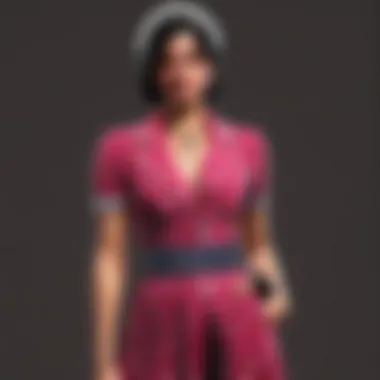The Timeless Appeal of Polka Dots: History and Culture


Intro
Polka dots. No matter how you slice it, these playful dots have made their mark across cultures and eras. Their aesthetic simplicity belies a rich history that stretches back to the 19th century, reflecting trends and sentiments of various generations. As we unpack the layers surrounding polka dots, we’ll dive deep into their origins, their significance in art and fashion, and even their psychological appeal.
What is it about these circular patterns that strikes a chord with people? Are polka dots a mere fashion statement, or do they carry a deeper resonance that transcends time and style? In this exploration, we aim to peel back the layers and understand the multifaceted nature of polka dots—how they’ve evolved, influenced, and captivated us throughout history.
The Historical Genesis of Polka Dots
The term
Preface to Polka Dots
Polka dots are not simply a repetitive pattern; they embody a rich narrative interwoven with cultural significance, history, and artistic expression. This article sets the stage for a comprehensive exploration of this iconic design, engaging readers with a blend of historical context and modern-day relevance. Why do polka dots captivate our imagination and appear across various mediums, from fashion to interior design?
Understanding polka dots means appreciating their multifaceted nature. At first glance, they strike an appealing balance between simplicity and exuberance, evoking emotions ranging from nostalgia to playfulness. Throughout the years, they have adapted to serve different purposes in both art and fashion, carving out a niche that resonates with diverse audiences. Moreover, they serve as a canvas through which societal shifts and cultural dialogues unfold.
In this section, we will explore the definition of the polka dot pattern and provide a brief historical overview. By delving into these foundational aspects, we lay a groundwork for the subsequent analysis of their cultural significance, psychological underpinnings, and contemporary applications. Such exploration not only enhances our appreciation of this pattern but also sheds light on its enduring allure.
Defining the Polka Dot Pattern
A polka dot is characterized by its distinct circular shapes that are arranged in a regular, repeating pattern. The dots can vary in size and color, but the essence lies in their uniformity that evokes a sense of rhythm. More than mere decoration, this design element can transform clothing, walls, and even art pieces into captivating visual narratives.
"The charm of polka dots resides in their ability to bridge the gap between simplicity and sophistication."
Polka dots can evoke different feelings depending on their context and implementation. For instance, vibrant, large dots on a bright background might evoke cheerfulness, while subdued, small dots on a monochromatic palette can convey elegance. This versatility is crucial in understanding why the polka dot design continues to endure in both fashion and art.
A Brief Historical Overview
The journey of polka dots is as vibrant as the pattern itself. The term "polka dot" is believed to have emerged in the mid-19th century, reflecting the popularity of the polka dance, which was all the rage in Europe at the time. This connection to a lively dance form solidified polka dots as symbols of playfulness and joy.
Initially, the polka dot pattern was predominantly found in children's clothing, but it quickly gained traction in women's fashion, appearing on dresses, blouses, and accessories. By the early 20th century, designers like Coco Chanel incorporated polka dots into high fashion, elevating the pattern's status from whimsical to chic.
Moreover, the cultural implications of polka dots have evolved. In the mid-20th century, these playful dots were embraced by youth subcultures, symbolizing freedom and rebellion. This historical trajectory illustrates how polka dots have transcended their origins, becoming a unique element in the fabric of fashion and societal expression.
As we traverse through the various levels of the polka dot phenomenon, we'll uncover their significance in contemporary culture while reflecting on their past. Understanding their evolution provides vital insights into how they continue to resonate across generations.
Origin and Evolution
The segment of this article - Origin and Evolution - serves as the backbone for understanding how polka dots emerged and morphed over time. Rooted in rich folklore and cultural histories, polka dots are not merely a fashion statement but represent a confluence of artistic expression, emotional resonance, and social trends. This exploration sheds light on their journey, reflecting shifts in societal norms, artistic movements, and the enduring allure that polka dots hold in contemporary culture.
The Beginnings of Polka Dots
Folklore and Cultural Roots
Diving into the folklore and cultural roots reveals the colorful tapestry from which polka dots sprouted. Various stories tie this pattern to celebrations, gatherings, and social unity in diverse cultures. Traditionally, such designs were often employed during festive occasions, invoking warmth and togetherness. A characteristic feature of this folklore is the symbolism associated with the dots, each representing community and joy.
By examining these roots, we can appreciate why polka dots have become a beneficial choice for exploration in this article. They are not just patterns but signify interconnectedness across cultures, demonstrating that a simple dot can carry profound meaning. The unique feature of these tales lies in their ability to bind communities, encouraging the use of polka dots in celebrations, thus offering a rich layer of cultural significance that enhances the narrative surrounding polka dots.
The Influence of Dance and Music
Moving forward, the influence of dance and music is equally pivotal in charting the course of polka dots’ existence. Originating in the lively dance form known as the polka in the early 19th century, this pattern became emblematic of the celebratory spirit inherent in folk dances. The key characteristic of this connection lies in how rhythm and visual patterns entwine, echoing the festive beats of polka music itself, making polka dots an unmistakable choice for those seeking joy and liveliness in their attire.


This unique feature of the dance and music connection showcases how patterns in clothing can physically embody the emotional tempo of cultural expressions. Enveloping an outfit in polka dots not only reflects aesthetic choice but also evokes an emotional response rooted in engagement and festivity. This dual role provides distinct advantages in affirming the appropriateness of polka dots as a subject of cultural evolution.
Polka Dots Through the Ages
Early Adoption in Clothing
The early adoption in clothing of polka dots marks a significant stepping stone in their evolution. Initially embraced by the fashionable elite, polka dot patterns began to symbolize a playful yet sophisticated aesthetic. The key characteristic here is the pattern's ability to feel both timeless and trendy, attracting various demographics over decades. As it gained popularity, it became a beloved motif associated with leisure and joy, a stark contrast to the monochromatic threads of earlier fashion.
This notion of fun, combined with sophistication, renders this subject a valuable aspect of our exploration. Clothing made with polka dots began to infiltrate the daily lives of many, transcending barriers of elegance, making it a favorable choice as the social classes began to interact more fluidly.
Transition into Wallpaper and Fabrics
Finally, the transition into wallpaper and fabrics illustrates how polka dots permeated not just clothing but also home decor and textile design. This adaptability signifies a major cultural shift, showcasing polka dots’ versatility in expressing personal and collective identity in various spaces. The key characteristic is their ability to bring liveliness even to sterile environments.
This transition reflects how polka dots serve as a brightening element for interior spaces. In the world of interior design, the dots create rhythm and visual interest, which is crucial when crafting a homely atmosphere. These transitions have widely influenced modern design practices, showcasing how cultural symbols adapt and thrive in varied contexts.
As polka dots evolved through the lenses of characters from fashion, folklore, music, and even domestic spaces, this narrative assembles a coherent understanding of their captivating journey. Encouraging ongoing dialogue about their significance in our time, these historical elements position polka dots as more than a passing trend; they become a resilient emblem of cultural engagement throughout the ages.
If there’s one thing we learn from polka dots, it’s that even simple designs can carry vast histories and meanings.
Cultural Significance
Polka dots have transitioned through various cultural lenses over the decades, emerging not only as a fashionable choice but also as a significant cultural icon. This section explores the layered meanings that polka dots convey within fashion and art. Understanding this cultural significance sheds light on why polka dots remain relevant and continue to resonate with different audiences.
Polka Dots in Fashion
The Rise and Fall of Polka Dot Trends
Polka dots have had their fair share of highs and lows in the fashion world. In the early 20th century, they were closely associated with femininity and youthful charm. Over time, their popularity fluctuated, sometimes being deemed too childish or overly nostalgic. However, each resurgence often brought with it a fresh reinterpretation, showcasing the timelessness inherent in this pattern.
The key characteristic of the rise and fall of polka dot trends is their versatility. They can be whimsical or sophisticated, easily integrating into various styles. Designers often play around with size and color, creating looks that feel contemporary. However, it's essential to note that while polka dots are a popular choice for many, their reception can also vary significantly with the changing tides of fashion.
A unique feature of polka dot patterns is their adaptability across different clothing items, from casual wear to high-fashion garments. This versatility makes polka dots an enduring choice, illustrating their unique ability to straddle multiple aesthetics without feeling out of place.
Iconic Figures in Polka Dot Fashion
When discussing polka dots in fashion, several iconic figures pop into mind. Think of the legendary outfits worn by celebrities like Marilyn Monroe and designers such as Yves Saint Laurent. Both have made a mark, establishing polka dots as a statement of boldness and confidence.
What makes these figures significant is not merely their association with polka dots but how they infused personal identity into the patterns. The playful yet sophisticated vibe of polka dots is often reflected in their attire, emphasizing their importance as a tool for self-expression. The unique feature here is the blend of nostalgia with modern sensibility that these iconic personas manage to convey, allowing polka dots to maintain status amidst fashion evolution.
Symbolism in Art and Design
Art Movements Embracing Polka Dots
Polka dots have found a special place in the world of fine arts, embraced by movements such as Dadaism and Pop Art. Artists like Yayoi Kusama elevate this pattern to a form of expression that encapsulates the complexity of human emotions—often evoking themes of infinity and identity.
The key characteristic of art movements that incorporate polka dots is their ability to distort reality while simultaneously maintaining a playful tone. They invite viewers to question their perceptions and the societal norms surrounding patterns and repetition. This feature contributes hugely to the dissection of modern consciousness, making polka dots a highly beneficial choice for various artistic explorations.
Modern Interpretations in Contemporary Art
In contemporary art, polka dots are seen not just as a whimsical pattern but delve deeper into conversations around identity, culture, and even technology. Artists utilize these patterns to create immersive installations or by mixing them with newer digital techniques to comment on our increasingly visual world.
The defining characteristic of contemporary interpretations lies in their layered meanings. Artists today employ polka dots to push boundaries and challenge viewers' thoughts, making them appear both trivial and profound all at once. This duality highlights an advantage in their adaptability across multiple contexts, allowing for diverse interpretations without losing their core essence.


"In art, polka dots are no longer just decorative; they reflect a narrative, a movement, a statement."
Through engaging with the cultural significance of polka dots, one can appreciate their multifaceted role across fashion and art. It illustrates how a simple pattern can encapsulate complex ideas, serving as a bridge between historical context and modern-day relevancy.
Psychological Aspects
The psychological impact of polka dots extends far beyond their visual appeal. Understanding the ways in which these patterns resonate with individuals allows us to appreciate their significance in cultural, social, and personal contexts. Patterns, particularly those as playful as polka dots, evoke responses that can influence mood, self-perception, and cultural identity. By examining how these shapes communicate meaning and emotions, we can deepen our understanding of our interaction with polka dots in both fashion and art.
The Psychology of Patterns
Color Psychology Related to Polka Dots
Colors define more than just aesthetics; they serve as mood influencers and psychological triggers. Polka dots, with their repetitive yet varied hues, create a unique interplay of emotional responses. Bright colors often evoke feelings of cheerfulness and creativity, while muted tones may project sophistication or nostalgia. The key characteristic here is how certain colors can amplify or diminish the expression of the polka dot itself. For instance, a vibrant red dot on a white background may embody a sense of excitement, making it a popular choice for festive occasions. On the other hand, pastel colors tend to impart calmness.
- Bright colors in polka dots can draw attention and create a lively atmosphere.
- Pastel shades, meanwhile, often contribute to a sense of tranquility and comfort.
Polka dots’ versatility in color allows designers to target different emotions and messages based on their intended audience - a concept that holds major benefit in the realms of fashion and art. However, one has to tread carefully; too much vibrancy might overwhelm the viewer while too little can undercut the charm of the pattern.
Associations with Playfulness and Whimsy
Polka dots are almost synonymous with playfulness, conjuring images of childhood joy and carefree spirits. This aspect lends itself well to many contexts, from fashion statements to home decor. The playful nature of polka dots can lighten the mood and evoke feelings of happiness.
Critically, the key characteristic of this playfulness is its ability to foster creativity. Embracing polka dots can be a form of self-expression—a nudge toward thinking outside the box. This whimsical quality in design often attracts a clientele that values innovation over tradition.
- In fashion, a polka dotted dress can speak to a person's daring and joyful spirit.
- In interior design, dotted curtains may create a space that feels less formal and more inviting.
However, one must consider the downside of playfulness; in certain professional settings, the vibrant whimsy associated with polka dots can come off as unprofessional or frivolous.
Cultural Perceptions
Global Variations in Interpretation
Polka dots are distinctive not only in appearance but also in meaning across different cultures. In some societies, they may symbolize joy and celebration, while in others, they might have deeper connotations relating to identity and status. Such variations contribute to the rich tapestry of how polka dots are received worldwide.
For instance, the Japanese often associate the pattern with childhood innocence, while in European fashion, polka dots may relate to sophistication and elegance. The key aspect here is cultural context; understanding this can foster greater appreciation and sensitivity in design choices when incorporating polka dot patterns into global markets.
- In countries like France, polka dots may connote chicness, while in others, they might simply represent fun.
- These interpretations highlight the benefits of cultural awareness in design.
Unique to polka dots is their ability to traverse boundaries while remaining relevant in each cultural setting. Yet, one must be wary of imposing meanings that do not resonate locally.
Polka Dots and Identity
Polka dots also intersect with personal and collective identity. Wearing polka dots might reflect one's personality traits—be it whimsy, creativity, or even boldness. Specifically, the self-identification that comes from choosing polka dots can signal group belonging or individuality in fashion circles.
Interestingly, the evaluation of patterns like polka dots can shift depending on societal standards and personal experiences. Their youthful vibe may appeal to one demographic while being dismissed as childish by others, leading to dichotomous views of identity.
- Individuals who embrace polka dot styles might see them as an extension of self-expression.
- Conversely, those who avoid such patterns may associate them with a lack of seriousness or maturity.
The unique characteristic here is how these variations reflect personal and cultural identities, allowing for dialogue around style and self-image, which can be both beneficial and disadvantageous depending on societal norms.
"Patterns do not merely adorn of surfaces; they embody narratives as diverse as the cultures and individuals that embrace them."


Overall, the psychological aspects surrounding polka dots reveal profound connections to emotions, cultural identity, and interpersonal expressions—all vital in understanding why this simple pattern holds such a powerful place across contexts.
Contemporary Applications
The contemporary applications of polka dots serve as a testament to the pattern's enduring relevance across various fields. In today's world, polka dots are not just a nostalgic motif but a vibrant choice for modern design, fitting seamlessly into contemporary fashion and interior aesthetics. This section shines a spotlight on how this pattern continues to captivate audiences, highlighting both its appeal and versatility.
Polka Dots in Modern Fashion
Current Trends in Apparel
Current trends in apparel featuring polka dots have been gaining momentum, especially as designers blend traditional motifs with fresh ideas. Currently, high-fashion runways showcase polka dot garments that range from casual streetwear to upscale ensembles. For example, dresses adorned with oversized polka dots paired with minimalist accessories create a harmonious balance that attracts both the young and the seasoned fashionista.
One key characteristic of this trend is the size and color variation of polka dots. Smaller dots often create a more sophisticated look, while larger dots evoke a playful or whimsical vibe. The ability to mix and match different dot sizes within an outfit can yield an exciting visual experience. This versatility makes polka dots a popular choice; they can easily be dressed up for formal occasions or dressed down for casual outings. However, one unique feature is that despite their adaptability, an overuse of browns or blacks along with polka dots can sometimes lead to a dated appearance.
Influence on Accessories and Footwear
When it comes to accessories and footwear, polka dots contribute something lively to even the simplest of outfits. Bags, scarves, and shoes featuring this cheerful pattern are often seen paired with monochrome attires to provide a striking contrast. This characteristic of having a bold statement piece has made polka dots a beneficial accent in contemporary style.
A unique feature of polka-dotted accessories is their ability to transform an outfit without overwhelming it. For instance, a pair of polka dot pumps can elevate a plain black dress to chic heights while remaining stylish and understated. On the flip side, there can be a disadvantage of excessive dot patterns clashing with printed clothes, which might overwhelm the overall look.
Impact on Interior Design
Patterns in Home Decor
In interior design, polka dots bring a sense of liveliness to spaces. The application of polka dots on wallpapers or accent walls can turn a dull room into a bright and inviting atmosphere. This trend is particularly beneficial for children's rooms or playful areas within the home, where joy and creativity are paramount.
A standout characteristic of using polka dots in home decor lies in their ability to play with dimensions. Polka dots can create the illusion of space when used strategically, especially in smaller rooms. One downside, however, is that excessive polka dot patterns may overwhelm a room, turning the design from playful to chaotic if not balanced correctly.
Furniture and Textile Designs
Furniture and textile designs featuring polka dots have also made a significant mark in modern aesthetics, contributing a bold flair and an eye-catching appeal to living spaces. Sofas, cushions, and curtains decorated with polka dots are increasingly seen in homes as they offer not only visual interest but also a touch of whimsy.
The distinctive nature of polka dots allows them to combine with numerous styles, from contemporary to retro. Their adaptability offers homeowners a unique opportunity to personalize spaces. However, one must consider that not all polka dot designs fit into every home aesthetic; choosing the right scheme and color tone is crucial to preventing a clash with other design elements.
"Polka dots are more than just a simple pattern; they are a celebration of joy and creativity in both fashion and design."
In summary, polka dots maintain a lively presence in both modern fashion and interior design, intricately woven into the fabric of contemporary aesthetics, serving as a symbol of a creative spirit that resonates with diverse audiences.
Ending
The significance of polka dots as explored throughout this article is not only their aesthetic charm but also their rich historical and cultural layers. Polka dots have threaded their way through time, evolving from simple folk patterns to icons in high fashion and art. Their appeal stems from a unique blend of playfulness and sophistication, making them timeless in various contexts.
The Timelessness of Polka Dots
Polka dots have a knack for dancing across decades without losing their charm. From the elegant circles on classic dresses worn by the stars of old Hollywood to modern streetwear showing them off, their versatility is admirable. This pattern resonates with people of different ages and backgrounds, continuously finding its place in cultural expressions. The enduring essence of polka dots lies in their ability to adapt, transform, and even contrast, depending on the societal influences at play. They embody a spirit of freshness and nostalgia, making it easy for designers to reinvent them in countless ways while keeping their fundamental appeal intact.
Future Directions
Emerging Trends in Design
The future of polka dots is looking bright with emerging trends that integrate technology and sustainability. Designers are now experimenting with digital prints, creating innovative textures and interactions. One key characteristic is the ability to create highly personalized designs using algorithms that study consumer preferences. This personalization factor has become a strong selling point as it caters to individual tastes while allowing mass production. Furthermore, the eco-friendly approach to fabric choices introduces a unique feature where sustainable materials are encouraged, making polka dots not just a fashion statement but a conversation starter about responsible consumption.
Potential Cultural Shifts
There’s a palpable shift in cultural perceptions surrounding polka dots as we're leaning toward more inclusive representations in design. This change reflects broader social movements striving for diversity and representation in fashion. The key characteristic here is the growing emphasis on making patterns that resonate with a diverse audience, breaking away from traditional interpretations. Consequently, this shift comes with both advantages and disadvantages. On one hand, it fosters creativity and promotes broad acceptance of unique styles; on the other, it can risk diluting the original essence of polka dots. Ultimately, this cultural evolution promises to transform how future generations perceive and relate to this iconic pattern.
"Polka dots are more than a simple pattern; they are a canvas reflecting our changing social tapestry."
As polka dots continue to evolve, they'll likely maintain their relevance in varying forms of art, fashion, and design, proving their adaptability and universal appeal. They remind us that even in the fast-paced world of change, some things maintain a constant presence, bridging generations and cultures alike.



